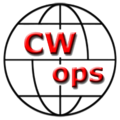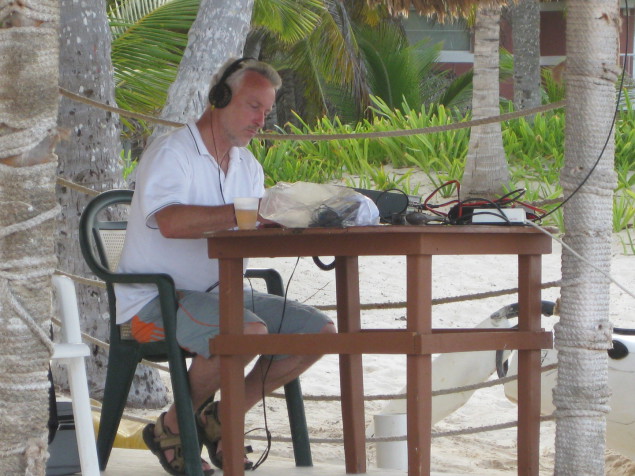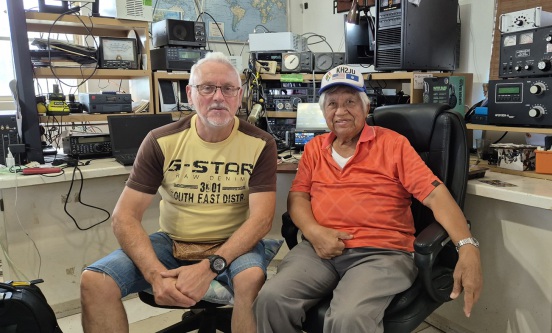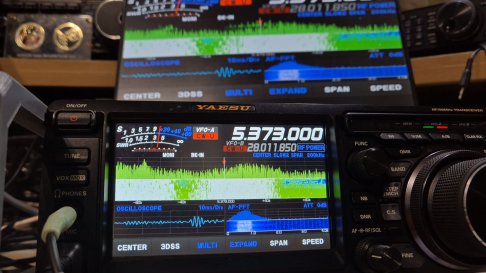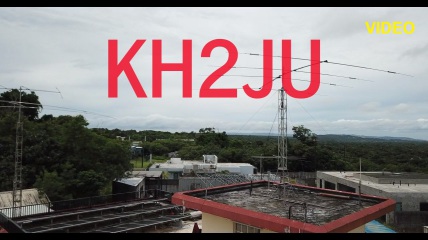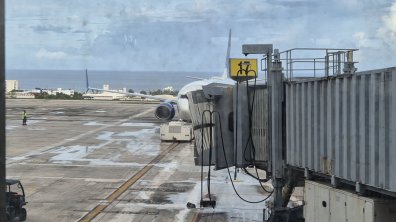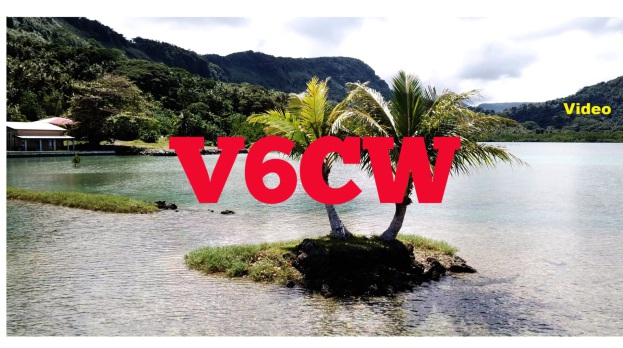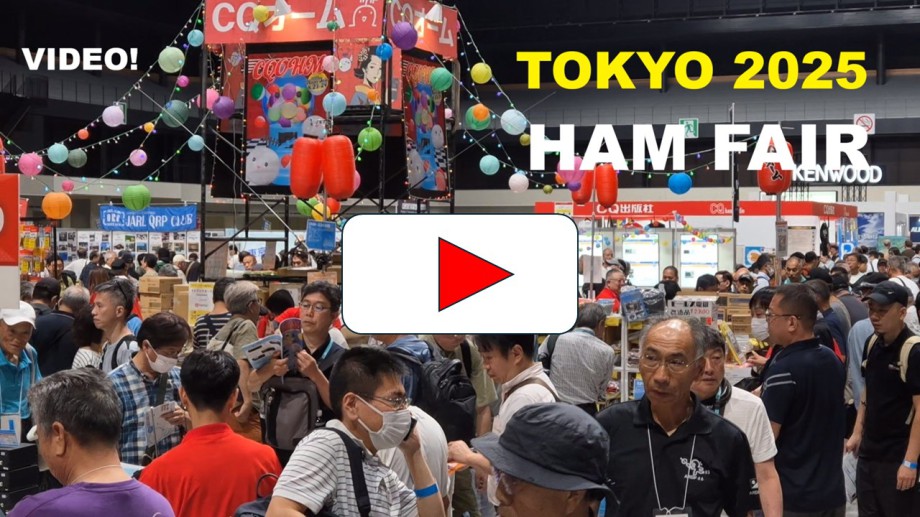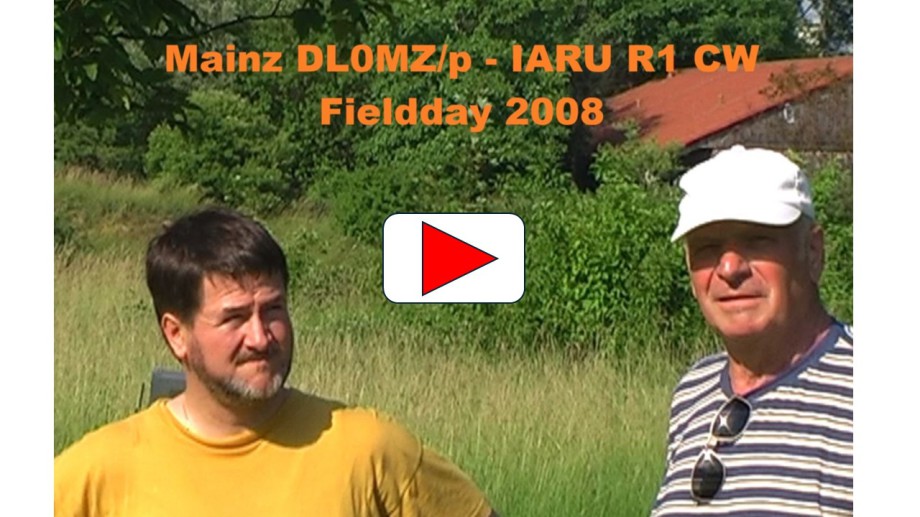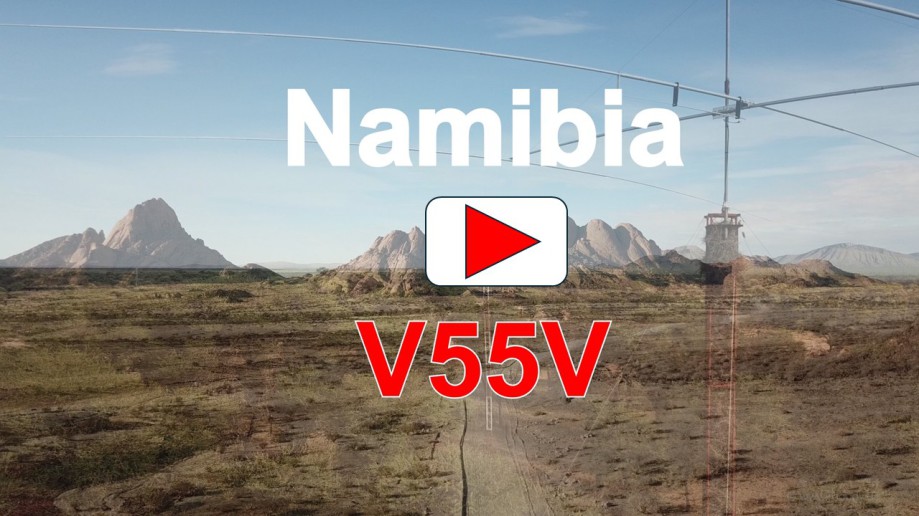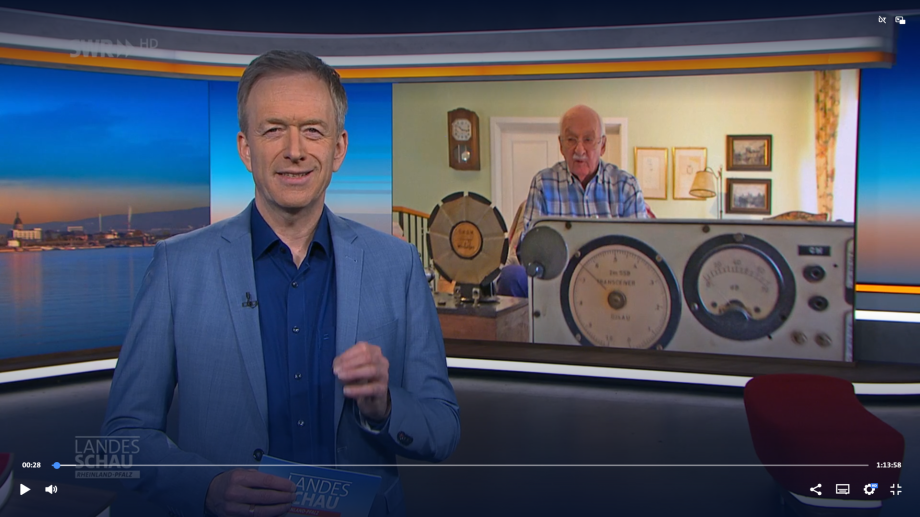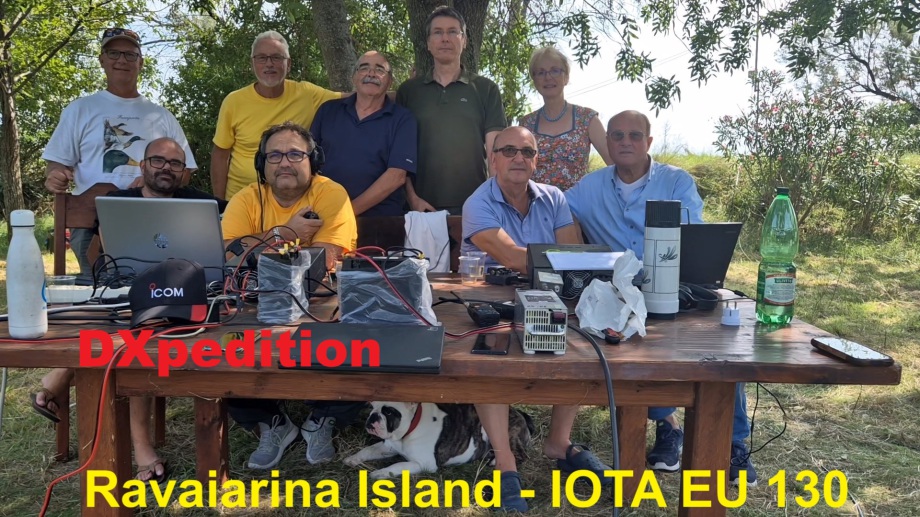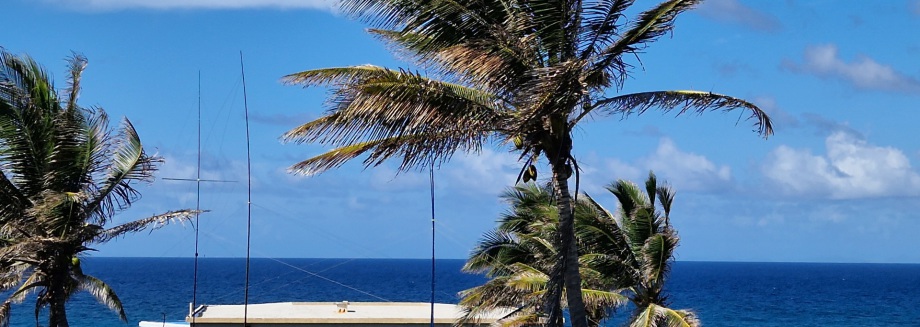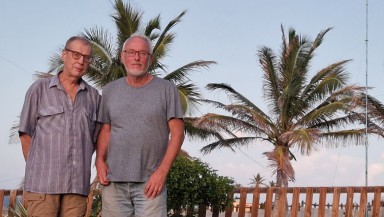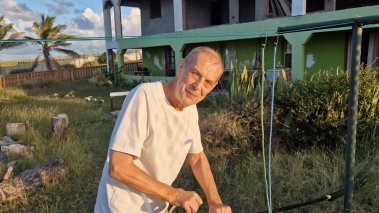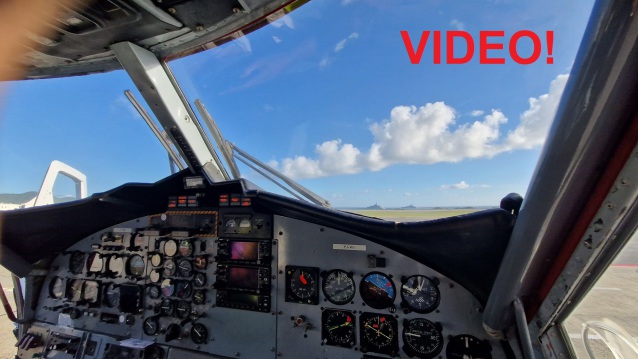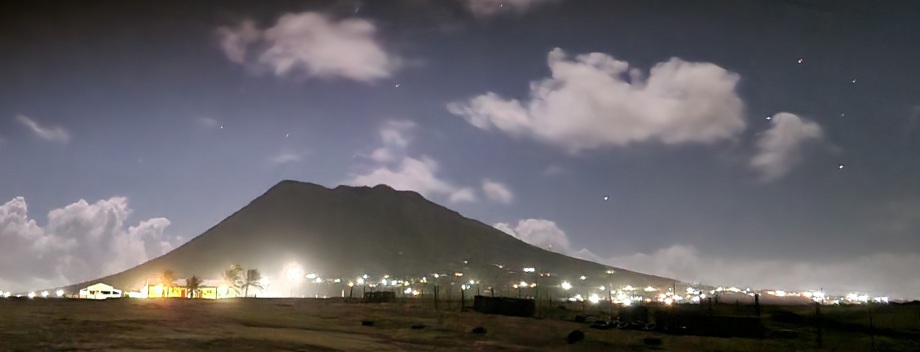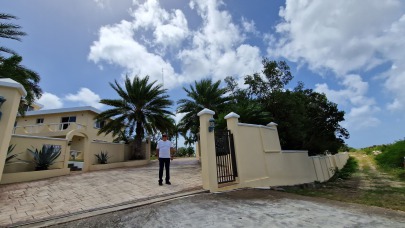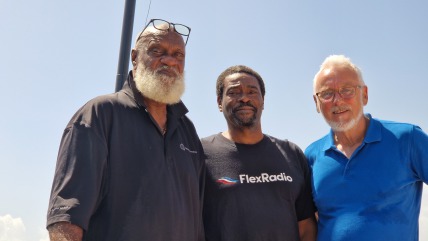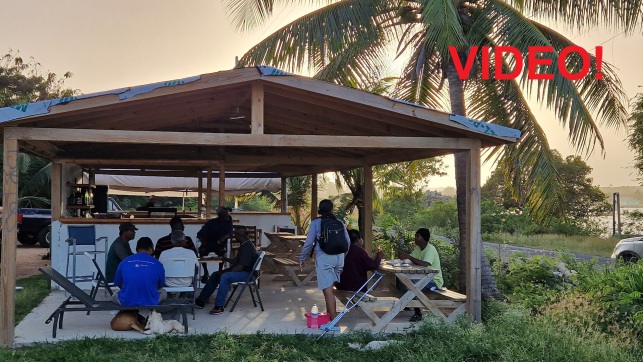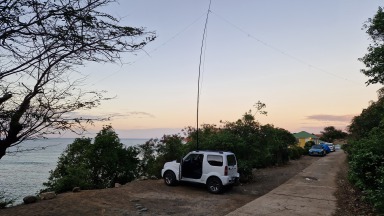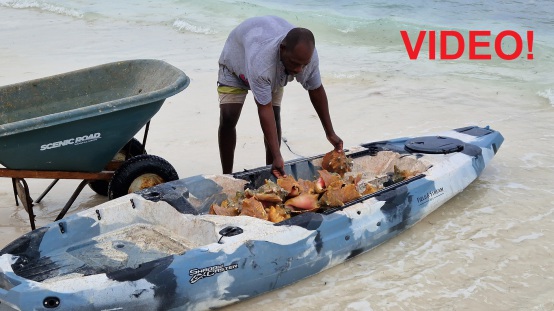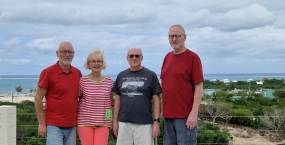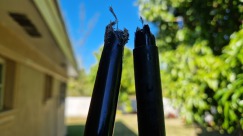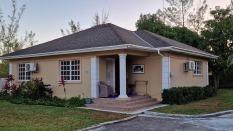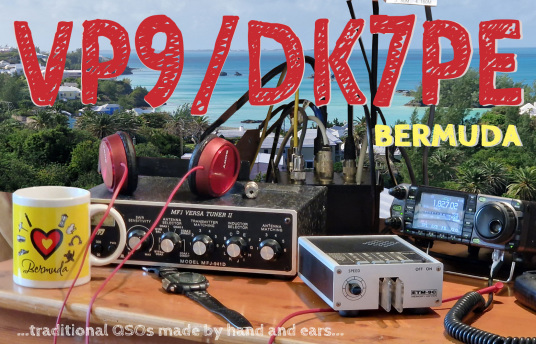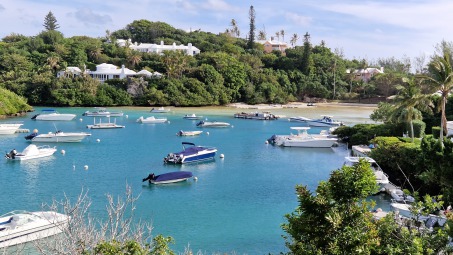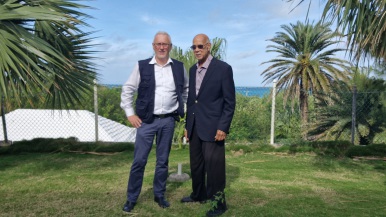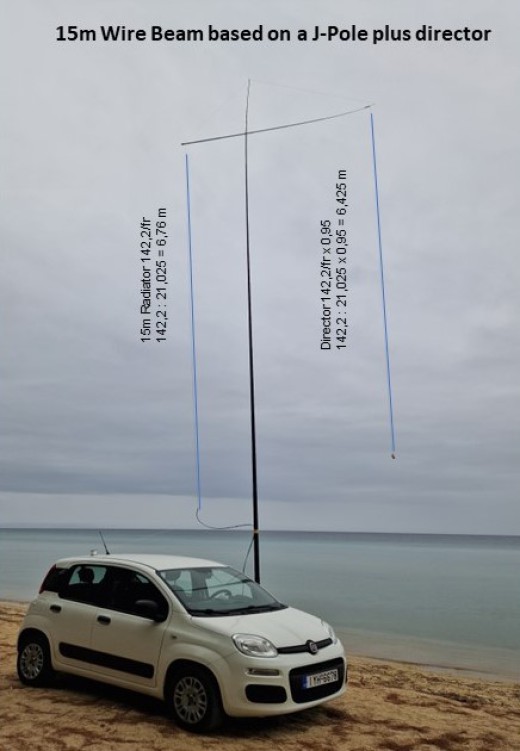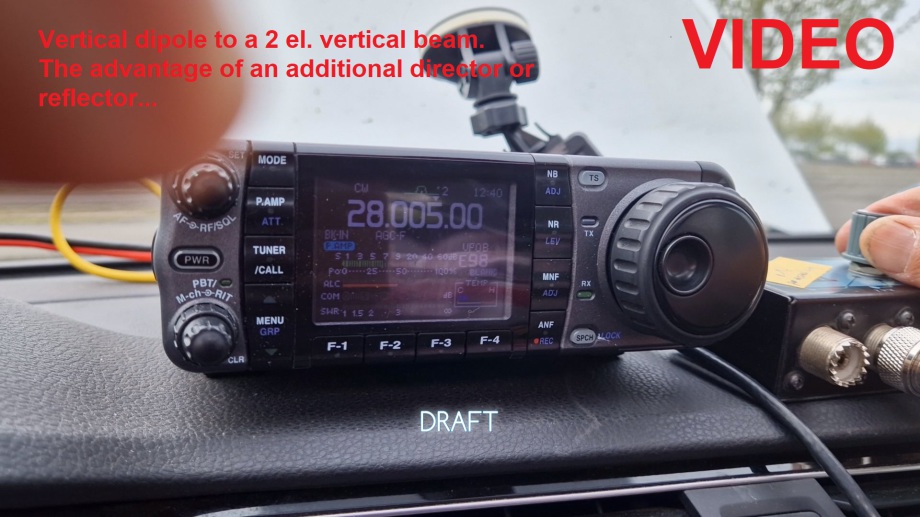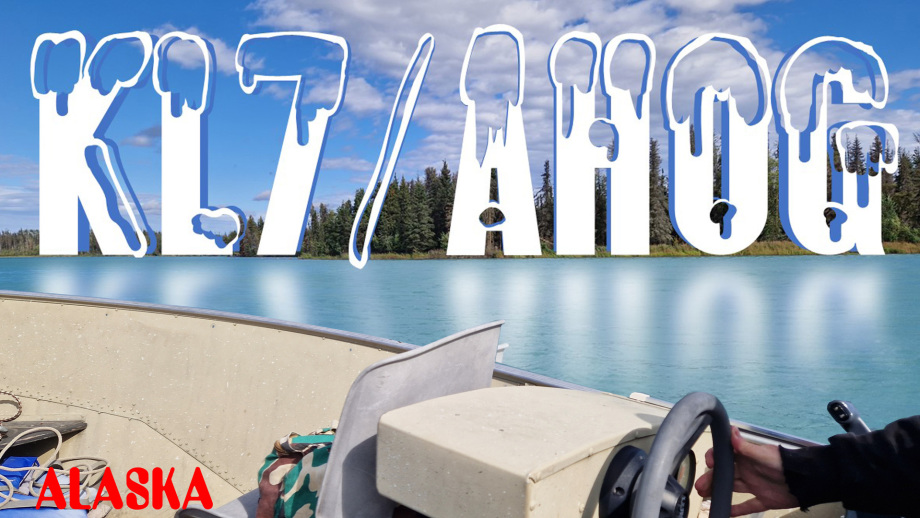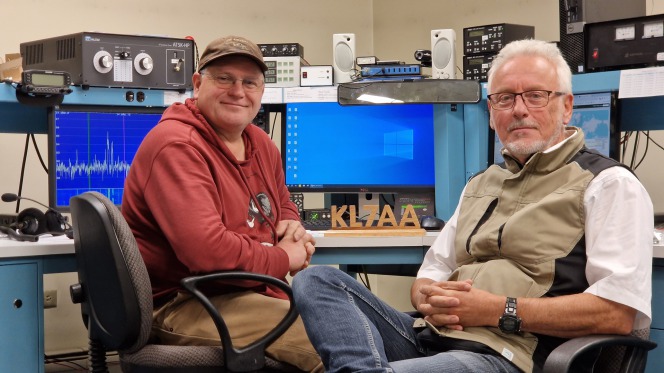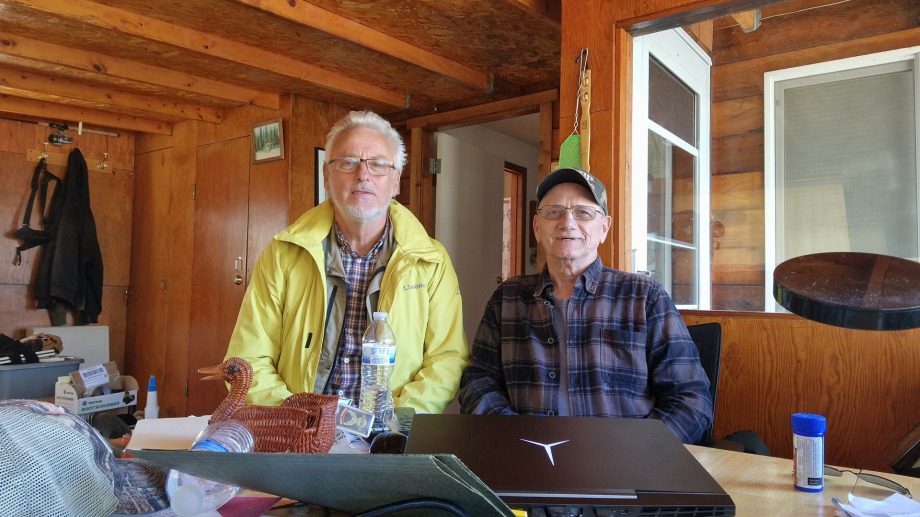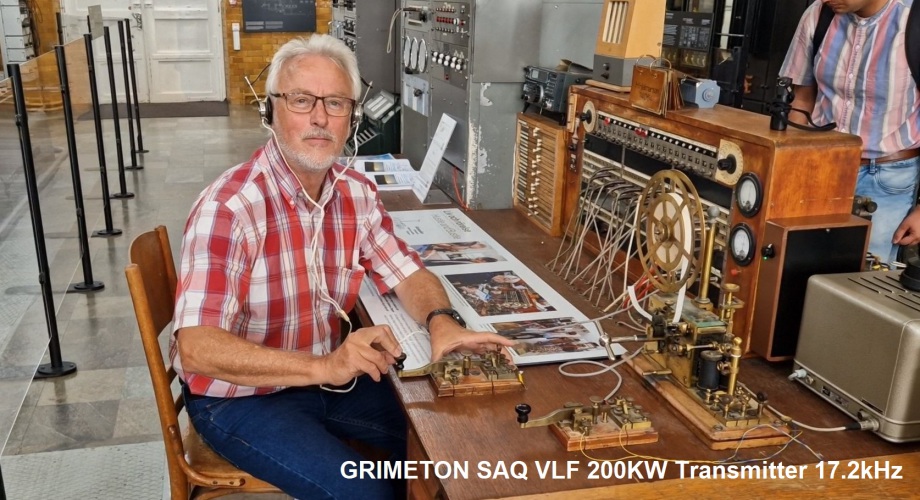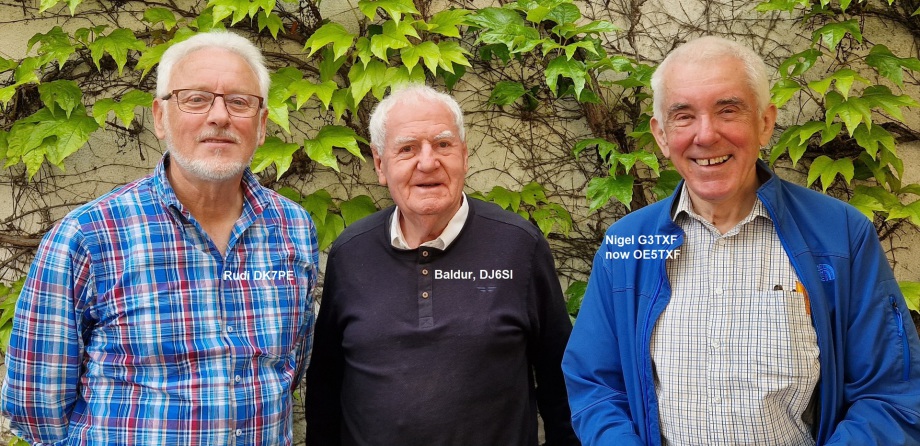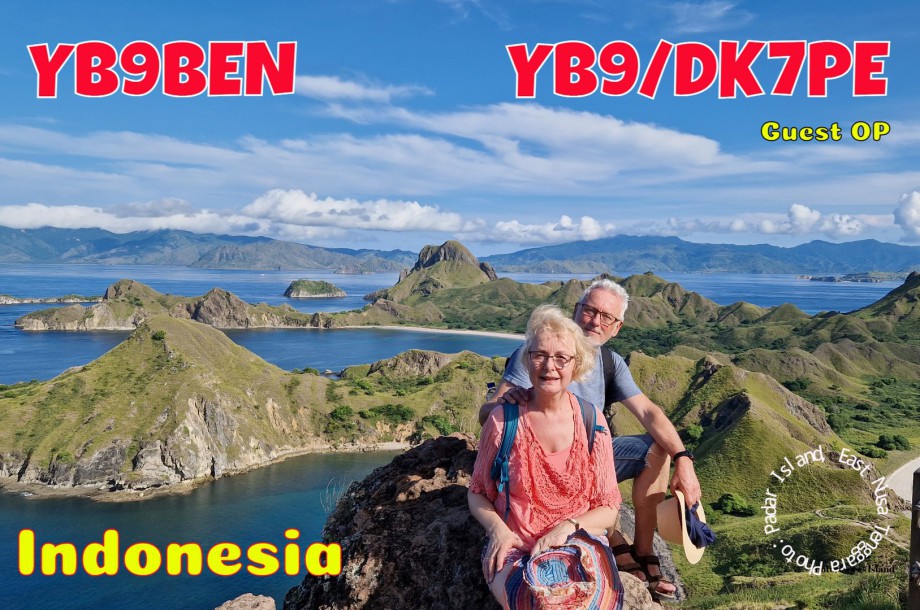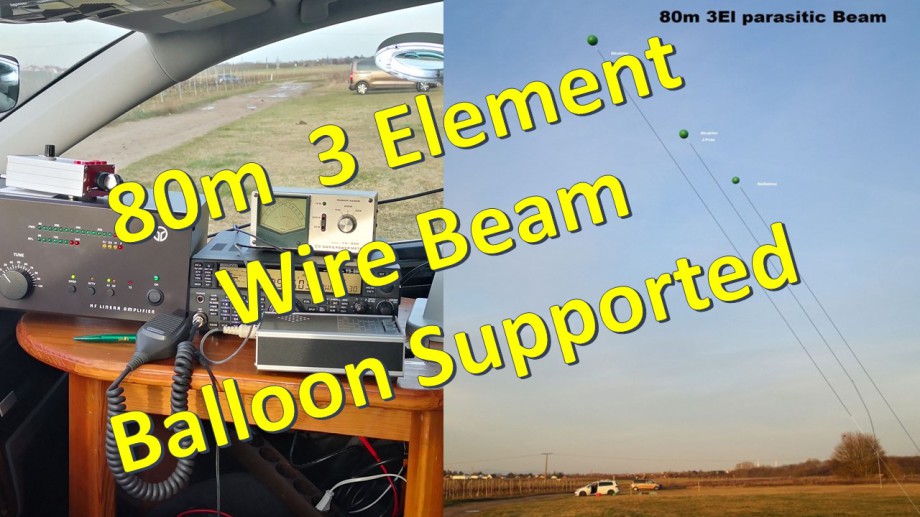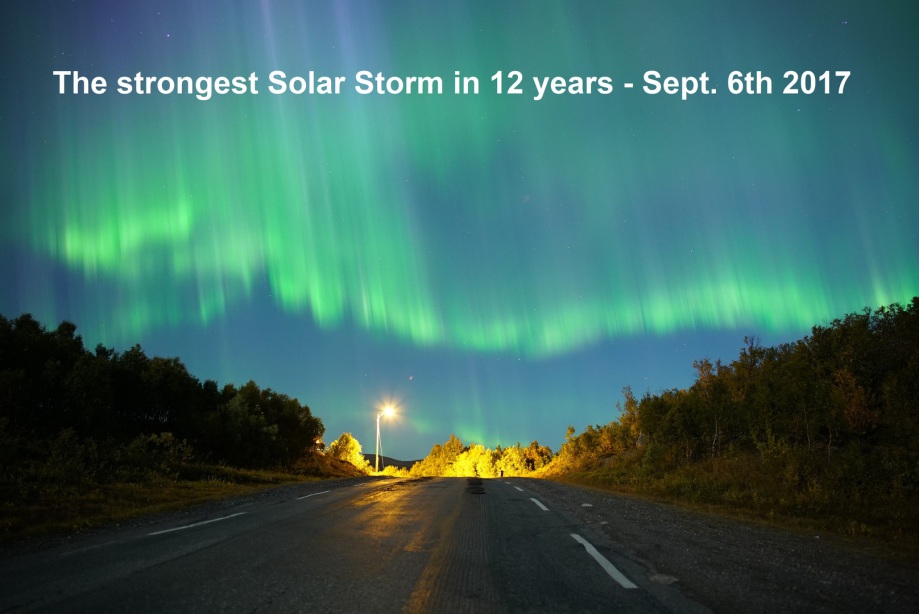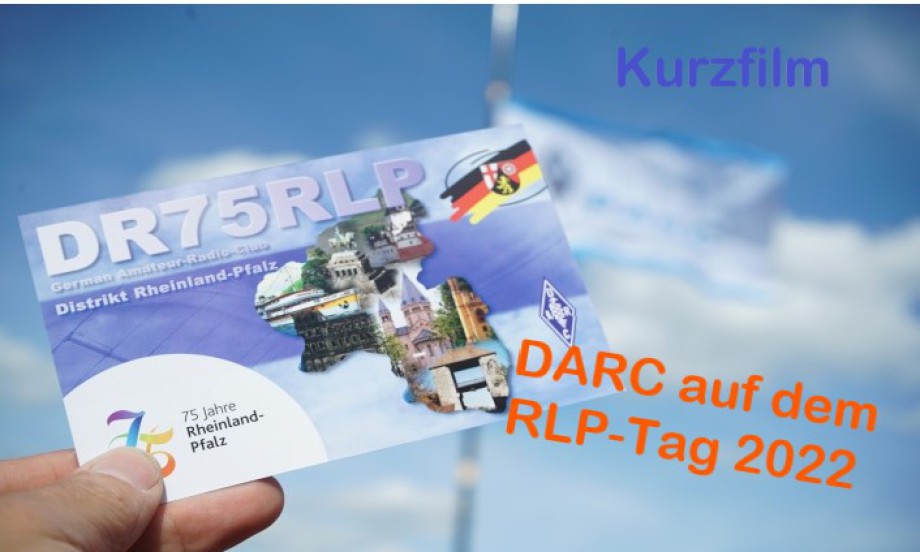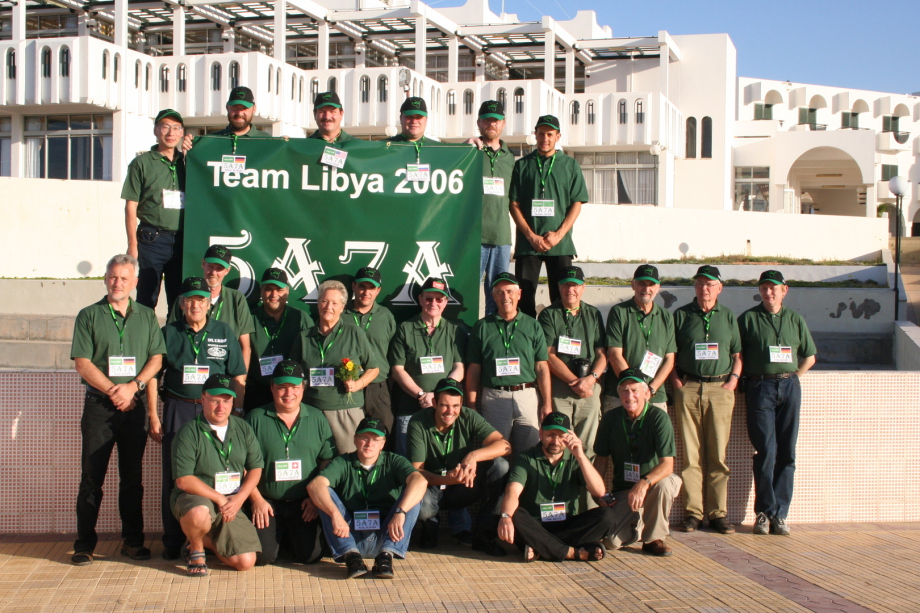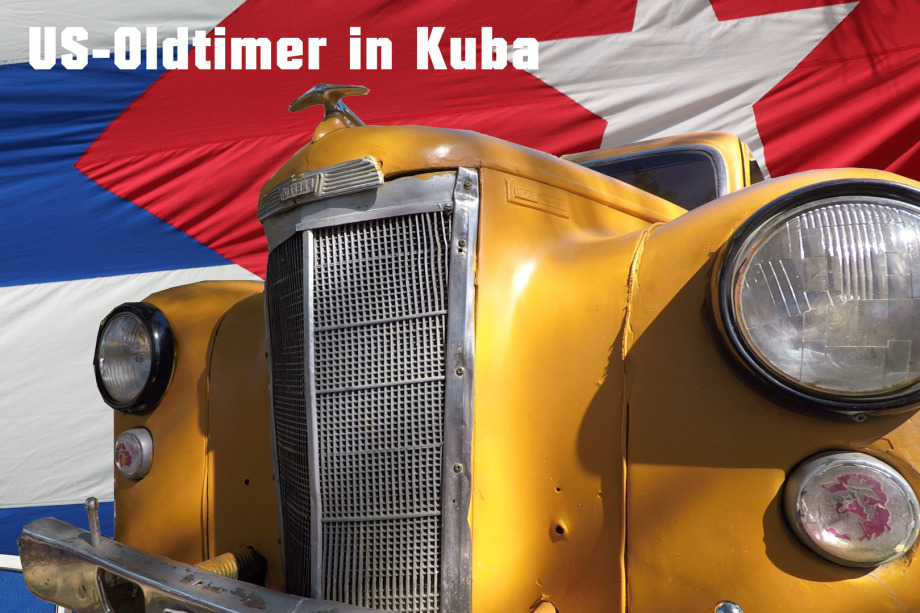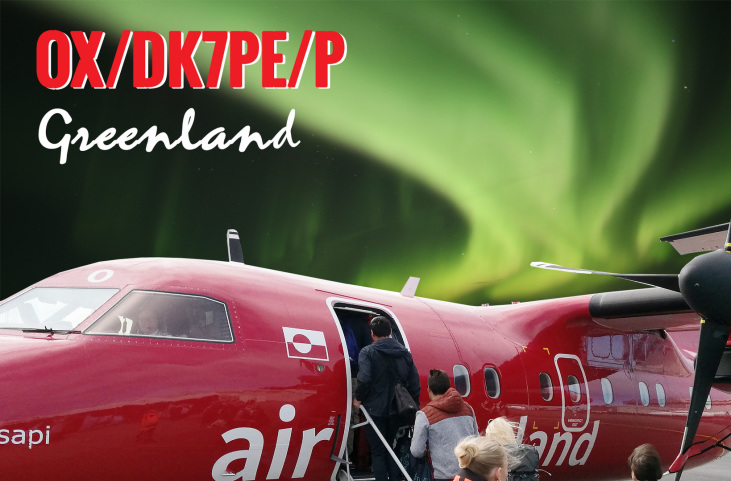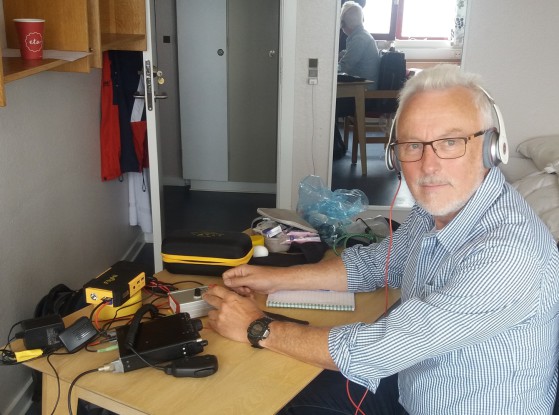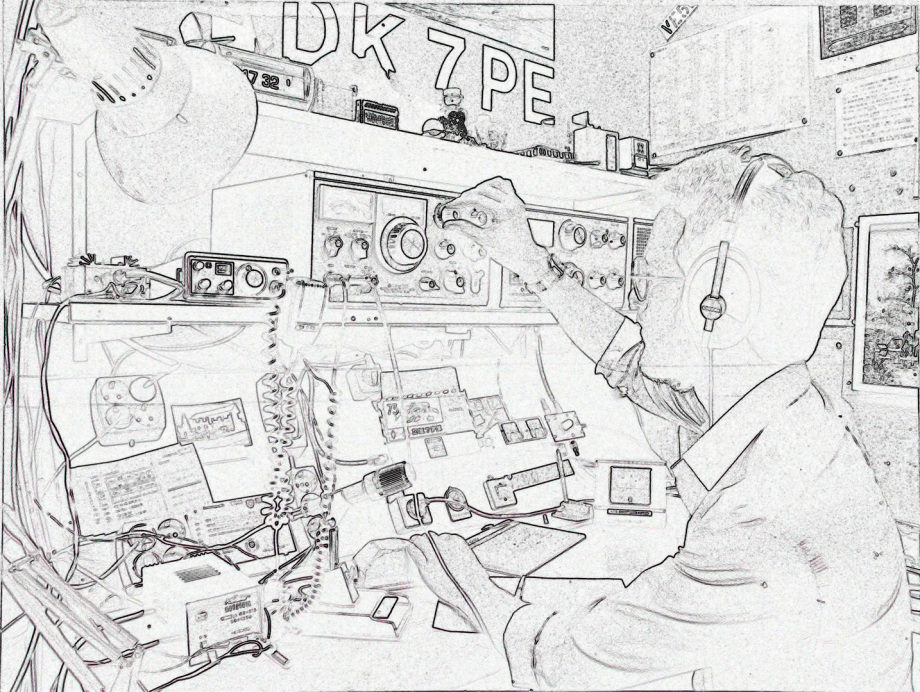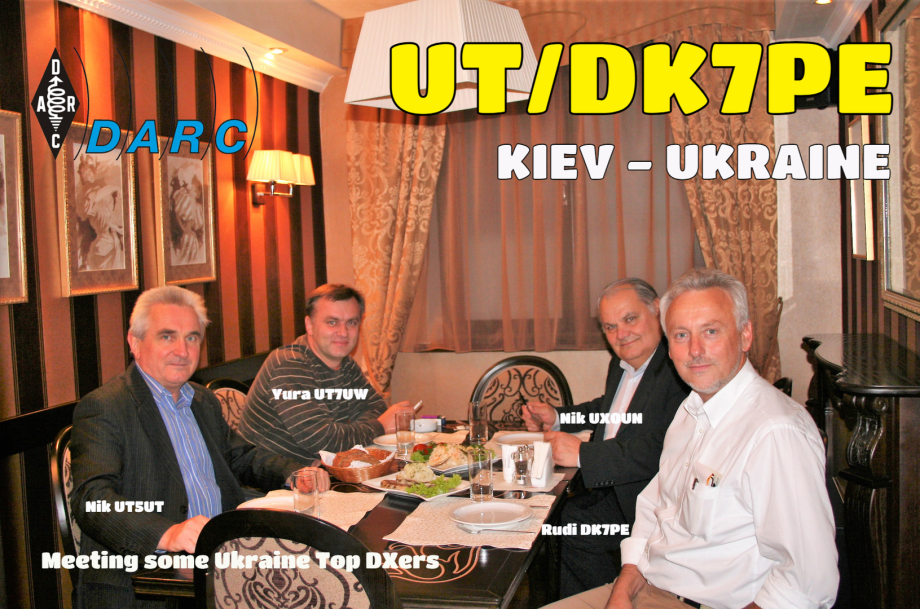
Third Pacific DXpedition Oct. 27th - Nov. 19th 2025 (start date changed!)
Oct. 27th. (start date had to be shifted from 25th to 27th) I will start to Tokyo and from there to Guam KH2/AH0G (not KG6...) QSL's for this operation only via DK7PE!
Next stop will be Palau (call T88MZ), Micronesia (V6CW), the Marshall Islands (V73RK) and possibly Kiribati (T30RK).
Chances to find an affordable HF location on the islands is very limited. The prices per night are exorbitant like in the Caribbean and an S9 QRM level is guaranteed on most locations. Room rates start from 210 USD near the beach, what is beyond my budget. Therefore I will also operate portable or out of a car, just running flat foot at 100W. The advantage is having a good location near the sea, but the disadvantage is that I have to build up and take down my antennas every day... That is why my operation will not be 24/7... It will be a mixture of DXpedition, antenna experimenting and meeting local radio amateurs. I will try several antenna constructions like my 2 or 3 El vertical wire beam, VDA's and Quad/Delta Loop antennas. Yes, I will try the low bands and of course 60m CW, where allowed. Every QSO will be "hand made" with a ETM9c keyer - it will be pretty much an old school One Man DXpedition.
What is IS DXFC?
The 'F' in DXFC stands for 'Feet' - countries in which you have stepped foot. DXFC is for licensed radio amateurs who like travelling. We DXers know all about DXCC so this is just our bit of fun. It works with the same 340 current 'entities' as defined at http://www.arrl.org/country-lists-prefixes. (Thanks Stewart G4AFF - www.dxfc.org)
DXFC has two rankings:
1. Stepping food on a DXCC entity without any amateur radio activity (DXFC Visits Total)
2. Stepping food on a DXCC entity and operate from there (DXFC QRV Total)
Oct 28th. 2025: Arrival on Guam Island Airport. Tim KH2XX and his son already waited for me to bring me to Danny KH2JU. Thank you Tim!!
Danny has a great location right on top of a hill. When Danny bought this place many years ago it was surounded by pure jungle. Now there is street and neigbouring buildings. He lives here with his very nice family that I eventually met.
Typhoons are big problem here, especially at this exposed location. Danny tells me that he lost all his antennas during Typhoon Mawar back in 2023 (speed up to 225 km/h). No antenna had survived this, so once again he built up everything new. He says: "I am used to that, after living here for over 50 years now..." In the garden behind the house I found some parts of a broken 50 MHz antenna. I was able to use it as a 6m beam with 4 elements. Before the typhoon it was a seven or eight element yagi...
Oct. 30th 2025: Meanwhile I have antennas for all bands from 160-6m ready. The TX signal seems to be very good. The bands above 20m work extremely good! Receiving on the lower frequencies is some kind of a challenge. This video gives you an impression on how the low bands sound like here on the island - most of the time. Maybe this explains why weaker stations have little to no chance to make it through the noise. I never heard that kind of noise before and I have no Idea where it comes from. Some say it comes from the OTH radar (Over-the-horizon) from somewhere...
I remember the woodpecker, but this sound was different.
d Oct. 31st 2025: This morning 40m was very good, because I found a clear spot between the S9+ OTH radar signals. Europe was very loud. I wish I had more of these days...
30m and the other low bands ws impossible to use.
Tomorrow I want to go to Micronesia (V6). Originally it was planned to go to Palau first, but as the license is not ready yet, I changed my plan.
Good news: Today, with the help of Gary T88SS, the Palau license arrived!!! Call T88MZ.
Nov. 1st 2025: Today I tried to make it to Pohnpei Micronesia (V6), but no chance. The flight was fully booked and so have to try again tomorrow...
This night the low bands sound much better. The horrible radar is gone, or at least by far not as loud as he days before. Unfortunately my precious fibrepole fell aside and broke into two pieces (each +/-5m) when I tried to build up a 30m antenna.
This is a real problem for me, as this pole is the base for almost all my antennas and I don't have a spare - as with all my equipment. Here on the Islands it was impossible to find at least a 10m fishingpole, some local HAMs told me. So I wait for the sunrise and see what I can do...
Nov. 2nd 2025: After sunrise I asked Danny for any spare parts that I can use to repair the fibre pole. To my surprise he had two used ones that he could lend me for my operation. One also had a missing tube, but the second one was fine - 30 feet! Just perfect to use all my wire antennas! Thank you Danny!!!
Now I had to hurry to the airport and this time I made it to Pohnpei (Federal State of Micronesia). Finding a place to operate from from Pohnpei was not easy, as expected. The China Star hotel was recommended to me, but it was located almost inside the container harbour, with powerlines everywhere. It was one o'clock in the morning, so I spend the remaining night hours in the rented car. Next morning I found an HF location right in the mangrove forest, in the north of the island - good for HF but with a standard less than basic... I decided to operate only during daylight and stay at the China Star during night. I prepared a short video to give you an impression on the location where I operted from. The family who ownes this property was very friendly and helpful to me. As a welcome they offered a drink right from the coconut tree.
Nov. 5th 2025: Arrival on the Majuro Atoll during a heavy tropical rain. Some earlier DXpeditions had operated out of the MIR (Marshall Island Resort) what was rated to be a good and affordable location. Indeed they knew about amateur radio and even remembered my friend Rolf, DL7VEE, who had been there some years ago, together with his team. How convenient it was. I could fix my antennas an leave them there. Nobody cared about me and my wires in the air!
QSLing: Paper QSLs will be printed like I do since over 50 years now
I will always use real QSL cards for the confirmation of a special contact. I like to take photos and design a "pretty" QSL after an operation. QSLs are personal reflections of the human being I have made contact with, even if only briefly. Cards often include comments of interest and I know that a real human being has borne the expense, and taken the time to write a response. It's like receiving a letter, and it is always a pleasant surprise to receive one nowadays.
Such a DXpedition is a very costly business.
I want to provide you with a QSO, a new slot (band point)
or even an ATNO.
Yes, your support is welcome!
For direct QSL requests please use the following address:
Rudi Klos, DK7PE
Ulrichstrasse 26
55128 Mainz / Germany
You may also request your direct QSL via OQRS to save the postage for sending the QSL In this case, please use my my PayPal address (PayPal for a friend):
Please don't send me several QSLs for different DXpeditions in one simple SASE... Thank you!
A word about todays One-Man DXpeditioning...
Going on a DXpedition offers great excitement to me, just like it does for those in the pile-up. It’s a thrill to go out and focus on the low bands by using CW, trying out new wire antennas and picking up signals out of the noise, like I have done since over fifty years now.
A night on 160 can result in a handful of QSOs only and sometimes no contact at all. While a single operator can make up to 8,000-10,000 contacts (SSB/CW) and even 30.000 (FT8) in one week on the higher bands, a low band operation with 1,500 QSOs is a very good result in that period of time.
The costs for such an "adventure" increases every year. For example, on my trip to Bolivia I was carrying 60kg (120lbs) of equipment and antennas with me, which resulted in very high excess baggage charges. No mercy from the airline...
There were times when I travelled to Africa carrying 72 kilo with me - that's long ago... On a trip to Zimbabwe (/22CW), I was asked to pay 1,300 Euros (approx. US$ 1,500) extra for additional weight/baggage. Guess what I did! I took a taxi and went back home, took out the heavy parts like amplifier etc. and returned to the Airport...
High costs for excess weight and baggage are the reason why I sometimes have to go "QRP" or 100 W only. There are always new additional charges... meanwhile I had to learn that bulky baggage (e.g. fishing rods), on certain flights, are charged with 250 Euros for each piece, and in each direction. Not because of the weight, just because they are bulky. Sure it depends on the airline, but there is always a surprise, be sure! I don't want to mention the increased prices for accomodation. The recent top for one night accomodation was 250 USD (!) on Turks & Caicos, and on Palau, Micronesia and the Marshall Islands it looks same, if you want to be near the waterfront.
The cost for my DXpeditions I pay all by myself, for transportation, oversize and excess baggage, accommodation, license fees and whatever... The costs for my last DXpedition the Caribbean was 6.000 €
As a one-man operation I have no sponsoring organizations like the big Multi-operator DXpeditions have!
I want to thank those individuals who have supported my DXpeditions in the past, either financially, built and repair of equipment or their help in general:
DK1EI, DJ8NK, IK0FVC, DJ2BW, XU7TZG, FK8CP, DL1BDF, DL5WO, DL0MZ, DJ8KZ, ZP6RO, DJ6QT, ON4UN, SU1ER, KH0AC, VP2VE, AP2JZB, K2GM, DJ6RX, DF3GY, SU1KM, DF2UU, KH7XS, DK6PR, V51W, DJ8CY, VP2MD, C6AKD,
Tom Perera, W1TP (rechts) ist Funkamateur seit 1953 und kommt mit seiner Frau seit vielen Jahren zur HAM Radio. Er besitzt gleich mehrere Original ENIGMAs und ist der Besitzer des einzigartigen ENIGMA Museums (enigmamuseum.com). Sein guter Freund Franz (links) war bis 2004 als Professor für Systemtheorie an der Johannes Kepler Universität in Linz tätig und ist Mitglied der GFGF und AWA (Antique Wireless Association). Beide zusammen haben schon dutzende Bücher über historische Telegrafieapparate und Morsetasten geschrieben - das geballte Wissen in Sachen Telegraphen und ENIGMA!
Rainer, DK4RS, Stefan DH5FFL und Rudi DK7PE (v.l.n.r.) auf der HAM Radio 2025. Stefan ist der Chefredakteur der cqDL und quasi eine One-Man-Show. Unterstützung in der Redaktionsarbeit bekommt er zwar durch Thorsten, DO1DAA, der aufgrund anderer Zuständigkeiten allerdings nur zur Hälfte zur Verfügung steht.
Redaktionsleitung, Heftplanung und Koordination, Festlegung von Themenschwerpunkten, Nachrichten, technische Beiträge, Deutschlandrundspruch, Berichterstattung von Tagungen/Messen und ständige Zusammenarbeit mit dem Herausgeber liegen also allein in seinen Händen. Und dann wären da noch die E-Mails oder die Anrufe derer die gern mal den Redakteur persönlich gesprochen hätten...
Das ist eine gewaltige Leistung und ich frage mich, wie kann man das alles schaffen kann. Chapeau!!!
Dann können wir nur hoffen, dass Stefan keine Extremsportarten betreibt, denn sein Ausfall, wenn auch nur für einige Wochen, wäre katastrophal für das Erscheinen unserer nächsten Clubzeitschrift...
Caribbean DXpedition Oct. 31st. to Nov. 18th. 2024
Since Nov 14th. I am on Barbados operating 8P9PE, the last DXCC entity on this trip. The accomodation is surrounded by power lines - no chance for a serious operation. Therefore I prefered to operated out of the car to be close to the beach and using a palm tree as a support. The paddle was placed on the passenger seat, always a little unstable. This kind of operation at least shows that there is a real human beeing behind. It has a "smell and a taste" as we say in Germany.
Nov. 13th. 2024: Today I met two famous radio operators from the Island of Saint Kitts. Joel V44KAI is a 100% CW man, while John worked 100% SSB in his life. John started in 1958 at the age of 13. He is a life and legacy member of ARRL.
John was working in the oil business for Schlumberger Limited (French pronounciation) or now SLB. One day the company needed a special analyzer sold by HEATHKIT. Instead of buying only the analyzers, Schlumberger bought the whole company for a bargain of only 50 Mio USD. That is the reason why you read HEATH and Schlumberger on the Heatkit equipment of the 70ies he said. Wow, I was wondering what Schlumberger ment, but now I have learned something new!
Nov. 12th. 2024: DXFC #172. I'm back from the Blackrock Cliff North-East of the Island. It wasn't easy to find a suitable place, as the road around the island runs several hundred meters away from the beachfront. Bush, palms and sugar cane plantations in between, and no access to the waterfront. I was about to give it up and return, when a friendly lady told me to try Blackrock Cliff one of the tourist attractions on the island of Saint Kitts. And indeed, this place was what I was looking for. I'd never have found this little unpaved road unless she had told me.The signals were super loud as expected and most importantly, I felt safe there, as it is not recommended to stay out alone somewhere, especially in darkness. While I was on the radio, three safari busses arrived with about 60 cruise ship people having a day tour. One of the drivers hurried up to me, took many pictures of my antenna and introduced himself as Christian, V44TT. Christian is a very colorful personality - and super nice guy! He found it great that I operated from here, where all the tourist could see it and ask him: "what is this guy doing and what is this antenna good for?". Christian is a tourist guide and his colorful outfit will certainly help that everyone on the island and all overseas tourists, will always remember this funny tour guide.
They left for their next attraction and I was the last one on the rock, not feeling that comfortable anymore, shortly before dusk... Openings were great, but when it went dark, a "strange guy" knocked on the car window asking for money. To me, that was an indication that I better QRT now. I dismantled antenna and radio within five minutes and said good bye... That's the reason why I suddenly went off during a nice 60m pileup...
Nov. 11th 2024: Today I arrived on the Island of Saint Kitts and tomorrow I will set up the station and get on the air
Nov. 09th. 2024: I didn't make it to St. Kitts as planned so I had to stay on Antigua for at least two days.
Staying on Antigua was great, especially because I met Renvil V21RW, a very nice guy born on the island. He told me about the best location to operate from and so we went to Devils Bridge yesterday (Sunday). Indeed, it was one of the best locations I ever operated from. No qrm and a free shoot from West over North to the East. Renvil also was interested in the antennas I carried with me, becaue Billy told him about on their daily 80m net. So we started with a 17m Delta loop, later we build a 60m Dipole (Jumper Dipole) and other konfiguration. 60m conditions were not as good as three days before, but I still worked many stations on this band.
By the way, today (Nov 11th 2924) I will try it again to St. Kitts, hoping for better luck...
Nov 9th 2024: Today's flight from Montserrat to Antigua we were three passengers and one pilot. The person sitting next to me lived on Montserrat and asked why I was visiting Montserrat and whether I liked it there. When I told him about amateur radio, he knew exactly what it was. He told me the story about Bobby Martin VP2MO* who saved the people there, when his amateur radio station was the only connection to the outer world back in 1980ies when a tremendous hurricane hit the island.
He even knew Billy, VP2MD, personally and since I forgot to give Billy my QSL card, I asked him if he could kindly pass it to Billy on his way back to Montserrat. "Sure, no problem, I'll do that!" he replied. And when I asked whom Billy would get the card from, the answer was: "from Ruben". Just Ruben? Will he know which Ruben? The answer was yes, tell him from Ruben, the Prime Minister of Montserrat...
*VP2MO Montserrat: Sir "Bobby" Errol Martin; Bobby was Knighted "Sir" as a result of his tremendous help when a toronado hit the island. Bobby was later in a serious car accident that claimed his wife and put him in a wheelchair. Bobby moved to the UK for better medical attention. Thanks to HAM Gallery K8CX
Nov. 7th 2024: Predominantly was a day of antenna testing. Billy is working POTO (Parcs On The Air), so he was eager to see all my antennas I carry with me. He was thrilled to see what systems could be set up in a very short time using the simplest means, and especially that everything fits comfortably in a backpack.
The picture below shows the full size Delta Loop that can easily be switched from 20 to 10, just like my Jumper Dipol that I use since over 40 years now.
Nov. 6th 2024: Strong QRM in Brades made me rent a car and operate from the east of the island. This part is more or less abondend since the Soufrier Hills Volcano covered the old airport of Montserrat under meters of ashes and lava. Nature is taking back everything and some roads that still exist are gradually overgrown by all kinds of plants. Since 1990 when people had to leave their homes, this area is forgotten. Animals that survived the catastropy have multiplied uncontrolled. You'll find countless amonts of goats and thousands of Donkeys roaming around. Especially the donkeys that destroy farmers plantations are a real issue. While the wild goats for some are a welcome change on the menu, no one wants to eat donkey meat...
Regarding amateur radio, it was a good decision to operate from here, although the wandering donkeys, close to the car, sometimes were a bit spooky when I had to go out and look for the antenna, during a pitch dark night.
 The smallest airplane I used so far - from Antigua to Montserrat. Barely to see behind the containers...
The smallest airplane I used so far - from Antigua to Montserrat. Barely to see behind the containers...
Oct 31st 2024: ZF2PE (DXFC #170) Arriving on Grand Cayman late in the evening. I didn't know what to expect there and what kind of operation would be possible - just a portable, operating out of the car or whatever... Adrian AA5UK (ZF2SS) had visited Cayman many times before and he knows everything about the Islands. He had given me all kind of infomation in advance and also mentioned ZF1A, the big contest station on the Island. This station is one of the biggest in the Caribbean and most of us have worked them before, especially during the major contests.
Nov 16th. 2024: Meeting some of the local radio amateurs - all members of the Amateur Radio Society of Barbados. The club station is located on top of a hill, a little north of Bridgetown. They have 35 members in total and this afernoon nine of them showed up to say hello, that is a great ratio! (we took the picture early, unfortunately the ones arriving later are not on). The station 8P6AW is equipped with two 40 feet towers and a T3FD antenna in between. This antenna is usable all frequencies from 1.9 to even 50 MHz.
What a happy coincidence, at the same time Vasek, OK1VVT, came with YL and daughter to visit Barbados on a holiday trip. Vasek is an EME man and great contester who just returned from Morocco. Twelve years ago he was part of the C5A DXpedition to Banjul, The Gambia. What a small world... Thank you Basil for organizing this DX meeting!
Oct. 28th 2024: Next Thursday I will start my trip to the Caribbean. My shedule is to arrive on Grand Cayman late in the evening Oct 31st, staying there until the Nov. 4th or 5th. I will be using the call sign ZF2PE. Montserrat VP2MCW and St. Kitts V4/DK7PE will be the following destinations. Depending on the time available, I will also visit one more Island, but this isn't confirmed yet.
By the way, the chances to find an affordable HF location on the islands is very limited. The prices per night are exorbitant in the Caribbean, therefore I will also operate portable or even out of the car. The advantage is having a good location near the sea, but the disadvantage is that I have to build up and take down my antennas every day... That is why my trip can't be a 24/7 operation, but rather a mixture of DXpedition, antenna experimenting and meeting some of the local radio amateurs. Every QSO will be "hand made" and it will be an old school DXpedition...
I will mainly use CW with my 100W ICOM IC 7000 plus ETM9C keyer and of course my wire antennas. Where possible I will even use some of my directional wire beams for the higher bands, for example the three element Backpack Delta Loop (see picture on the left) which I can modify for several bands from 20 and 10m just by closing and opening the jumpers, or the two or three element Vertical J-pole Beam (see pictures below).
Yes, I will try the low bands and of course 60m CW. I'm looking forward to meeting you!
The Three Element Backpack Delta Loop out of a 10m fibre pole in connection with two horizontal light weight rods forming the boom. I will describe it later in a separate column.The whole antenna fits in my backpack! Compared to a vertical dipole it produces a huge advantage of at least one to two S-Units on DX contacts. I can switch it to 12/15/17 and 20m by using little jumpers. This system is absolutely light weight and the heaviest part is the fibre pole...
Über was ich mir sonst noch Gedanken mache...
Über einen Mangel an anrufenden Stationen kann ich mich hier in der Karibik absolut nicht beklagen. Anders sieht es aus, wenn ich von DL aus cq Rufe und keine Antwort bekomme, obwohl ich überall im RBN in den USA gehört werde. Wenn ich dann sehe, dass richtig gute US-Stationen (Big Guns) zur gleichen Zeit in FT8 gespottet werden, dann bin ich sprachlos. Haben diese om's die Freude am eigentlichen Gespräch oder einer Telegrafieverbindung in Klartext verloren oder warum sind sie so selten zu hören?
Interessant finde ich auch, was sich so in den letzten Jahren in Sachen DXpeditionen verändert hat. Vor einiger Zeit habe ich das Team einer Funkexpedition vor Ort besucht und wir haben uns prima unterhalten, bis ich plötzlich bemerkte, dass am Stationstisch ein Sender arbeitet. Auf meinen Hinweis: "Ooops your Transmitter is still on", kam die lapidare Antwort: "don"t worry, it’s only FT8!"... besonders bizarr wird es, wenn die anrufende Station, bzw. der OP selbst gerade mit Erdnüssen vorm Fernsehgerät sitzt und die Computer alleine ihr Ding machen... das ist sicher nicht die Regel, soll aber schon vorgekommen sein. Das kann es doch nicht sein, oder? Ein anderes Beispiel: Eine Gruppe von super CW-Operatoren führt eine aufwendige DXpedition ans andere Ende der Welt durch und ist überwiegend in FT8 gemeldet. Oder: Eine dreiwöchige Einmann-DXpedition mit mehreren 10.000 Verbindungen ist normalerweise der Hammer... oder doch nicht, falls der Computer die ATNOs (All Time New Ones = Erstverbindungen) 24h rund um die Uhr eigenständig einsammelt? Aber wer weiß das schon? Das ist eine Frage die sich jeder op selbst stellen muß. Die dadurch generierte finanzielle Unterstützung jedenfalls schafft ungeahnte Möglichkeiten...
Die Faszination der Technik hinter den Digital Modes stelle ich nicht in Zweifel. Dieser Bereich ist ein genauso wichtiger Bestandteil unseres Hobbies wie der eigentliche Funkbetrieb von Mensch zu Mensch. Die Möglichkeiten für Antennengeschädigte oder QRM-geplagte, die froh sind, irgendwie ein "QSO" fahren zu können, stelle ich auch nicht in Frage. Der eine macht SSB, der andere CW oder RTTY und warum jetzt nicht auch FT8. Wenn FT8 manuell, also QSO für QSO genutzt wird, dann ist das völlig in Ordnung - alles Geschmacksache!
Ich frage mich eher, was ist aus der "Faszination Amateurfunk" geworden die uns damals zur Lizenz bewegte? Die Freude, sich mit anderen Funkamateuren rund um den Globus unterhalten zu können, sei es in SSB, CW oder RTTY. In FT8 ist meines Wissens ein solcher Austausch nicht möglich. Liegt es wirklich nur daran, dass FT8 neuerdings als Mode im DXCC-Programm gezählt wird und dadurch eine gewaltige Nachfrage kreiert wurde, und jeder der seinen Länderstand halten oder verbessern möchte, quasi gezwungen ist mitzumachen? Das wäre für mich zumindest eine Erklärung, warum so viele jetzt nach FT8 abgewandert sind. Es gibt dort so viel zu tun. Vielleicht wird sich die Situation ja wieder normalisieren, wenn jedes Land irgendwann in FT8 "abgearbeitet" wurde - wer weiß?
Letztendlich muss jeder für sich selbst entscheiden was er unter Amateurfunk versteht und ob er seinem Computer das QSO fahren überlässt oder lieber selbst ein QSO fährt, aber einfach mal über die momentane Entwicklung nachzudenken hat noch nie geschadet...
73s Rudi DK7PE/8P9PE - mit Freude am Funk ;-)
Meeting some active radio amateurs from Syros Island (Cyclades)
Oct. 9th. 2024 Syros Island (IOTA 067): Mariza (SV8OVH), Karolos (SV8JVJ) the secretary of SZ8ERS, Vassillis (Bill) (SV1AZL), George (SV8OVJ) and Carlos (SV8IIR). They all are members of the Radio Amateur Association of Cyclades (Cyclades DX Club) and they meet every Sunday in the city of Ermoupoli. The famous club call sign SZ8ERS is active on different occasions. SZ8G for example was used during the International Lighthouse Lightship Weekend from Gaidouronisi Island and J48FT was used on Tinos Island. All members provide their time freely as emergency communication volunteers within GSCP. Vassili is a great CW operator since his early twenties and he’s a living legend. He started as a professional radio operator on ships and later he was working at the Coastal Maritime Station "SVA" (same as Norddeich Radio). He loves CW and worked well over 300 DXCC entities and won many CQ and ARRL contests (see his web site). George, SV8OVJ, took up the position as a Radio Officer in Merchant Marine right after leaving school. He learned CW as a young man and even now, at the age of 75, they say with a smile: “You won't get him away from the key (Paddle built by Carlos) during our special events. If you let him run, he sometimes ends up with 1100 QSOs in a single day - he is really fast at QRQ!" Carlos, SV8IIR, is the mechanic in the Club. He likes experimenting with new antenna designs and as a professional mechanic he even built a magnetic morse paddle that can be seen on his web site at QRZ.COM. His wife Mariza, SV8OVH, Is a great RTTY operator. She was #1 in the 2019 WPX RTTY contest and she already got invitations from abroad to take part in a RTTY contest! There were so many things to talk about amateur radio and DX, in the past and in the future, that we could have talked for many hours more. Meeting you was a highlight on our trip to the Cyclades - thank you! That's what amateur radio is all about!
Radiosonde flight August 5th 2024
Weather conditions today were just perfect to start another amateur radiosonde experiment. This time, Wolfgang (DF7PN), equipped the balloon with a 10 milliwatt transmitter and a 20m full size vertical Dipole. Everything is absolutely light weight with a total of less than 50 grams! Power is provided by a little solar panel, therefore the transmitter will "sleep" during night and comes alive after sunset.
The transmitter is operating on 14,097.2 MHz in WSPR digital mode. The predicted route leads to Italy and maybe even further to North Africa, depending on the winds. Theoretically it is even possible to circle the whole globe, but let's wait and see...
Immediately after the start around 07:00 UTC, the signal was heard in Tasmania/Australia (VK7) via long path over South America. That means the little 10 mW signal was heard over a distance of 25.000 km - not bad for the beginning!
Radiosondes - another exciting part in our great hobby!
Feb. 28th 2024: Meeting Janusz on his wire antenna farm on Sint Eustatius Island. After several trips to PJ5 he knows the best place to operate from. He choose a very remote location on the east coast, only 200m from the sea - no neighbours, lots of space for all kind of antennas and pure HF, without man made noise! Janusz is on DXpeditions since fourty years now and he knows how to built antennas. What he is using here is the result of many years experimenting.
The house has two spacy appartments and Janusz had no objections that I use the second one. I will do CW, while Janusz works on SSB and FT8. By the way, I just finished a pileup on 60m with very good signals from EU. At the moment (01:00 UT) the band is quiet, so I wait for the sunrise in EU...
Of course we compared the vertical half wave antenna with the single quad element. Yes, the test conditions were not quite equal, because a quad has a full wavelength and a natural gain of approximately 2 dB compared to a half wave antenna... The test confirmed that, and the quad element was louder in Europe by around one S-unit! Still the most effective and easiest to built antenna on a DXpedition is a vertical (Dipole or J-Pole) as it needs no tie wires and has almost no mechanical challenges... Anyway, the test convinced me that I will try a quad element next time - where possible.
Feb. 27th 2024: Boat trip from Anguilla to Sint Maarten, followed by a Twin Otter flight to Sint Eustatius (PJ5). I arrived in the evening and was lucky to get a small Hyunday i10. That was the only car available. I looked for a place right on the east coast and started to operate (see picture). As I was absolutely overtired, it happened that I fell asleep during a QSO - sorry about that! The picture with the vulcano was taken during the night. Tomorrow I will meet Janusz PJ5/SP9FIH.
Feb.: 26th.: I was wondering about several huge antenna towers far away on top of a hill at the north side of Anguilla. They didn't look commercial, rather like the remainders of a real big amateur radio station... I gave it a try and went there over a bulky road, never thinking to meet anybody. No bell, just the plate saying "SAWTELLE VP2E". This call was familiar to me and I have worked this station many times during the big contests twenty years ago. A friendly man was waving at the balkony, saying "hello, I'm coming down". I felt like he had already expected me. It was Gordin N5AU, one of the contest crew. Gordon is a very friendly man who showed me around the antenna farm or better what is left of it and told me about the activities back than. Several huricanes includig IRMA hit the antennas, but the big 55G towers all survived and still stand there. The FT 1000 radios are still there, but due to the climate and the salty air, they wouldn't work anymore. The last valid VP2E logged is dated March 8th 2011 and it doesn't look that this great station will ever come back on the air...
Feb. 25th 2024: Last Friday I arrived on Anguilla Island by ferry from St Barth via Sint Maarten. After one week operating out of my "SUZUKI Hotel" in St Bath, I now enjoy a real room! First I had to take a few hours of sleep. Did you ever experience a microsleep while running a pileup? That's weird and happened to me during several DXpeditions in the past, so in St Barth. It's a clear sign of your body saying that you better take a nap...
As my antennas were pretty spoiled, now I had the space to repair them - if I only had a soldering iron... My friend Jan DJ8NK who operated from VP2E several years ago, knows most of the local HAMs and is a very close friend to Keith VP2EKG. I don't know what Jan told him, but within a few hours, Keith, the president of AARS (Anguilla Amateur Radio Society) himself drove by and and brought me the needed tool - whow, that was great! He is a professional journalist and broadcaster here in The Valley, who originally lived on the island of Montserrat, using the call sign VP2MEG. He was reporting for Radio Antilles (Montserrat) right on scene during the disasterous vulcanic eruption that destroyed half of the Island, back in 1997. After that catastrophy, half of the population moved away from the Island and Keith and his family came to Anguilla, where he met Teddy Edwards, who later became a radio amateur too. Teddy got he call VP2ETE and is the beacon from Anguilla in SSB and FT8. Everybody seems to know him and when I talked to friends in Germany, they replied: "Oh, please pass my best regards to Teddy, we have worked him on this and that band and mode...". During our talks, we came to the conclusion, that amateur radio to all three of us is our life and the entrance to the whole world. It's such a great experience to meet these guys here on the Island!
Foto, left to right: Teddy VP2ETE, Keith VP2EKG and Rudi VP2ERK
Antenna problems still exist: Once again it happened that the jumper dipole suddenly was out of resonance with an infinite SWR. How does it happen? For the first time ever I had built this antenna out of a very light weight wire with an additional synthetic fibre inside. I observed a strange behaviour in C6 and VP5 but it was even worse in FJ. So I took off all the small jumper plugs and directly twisted the wires together, to make it a perfect connection. Now I know that this may only look like a perfect connection, because the synthetic fibre can make a perfect isolation. Yes, that is unbelievable! If you have such a poor connection in your antenna, you don't need to wonder why it is not working! So I burned the fibre away and twisted the pure wires. Now it works fine like all these antennas before, Conclusion: The wire might be great because of it's strength and the very low weight, but for a portable antenna like this, never again.
Feb. 22nd 2024: I just received my Anguilla amateur radio license with the call VP2ERK. Tomorrow I take the ferry to Marigot (Saint Martin) and from there I have to take the boat to Anguilla. I might have to stay one night in FS, depending on the arriving time there. Tonight is my last activity from St. Barth. I will stay away from the classic bands, as they are represented in major contests. So I concentrate on 30 and maybe 60m. I have the feeling, there is a high 60m demand from Europe.
Feb. 20th 2024: I arrived on St Barth after after a short Twin Otter flight from Sint Maarten, while Petra was on her way from Miami to Frankfurt. Due to the high season, the situation at the airports in Miami (Immigration and security) and especially at the whole Pleasance Airport TCI was as chaotic I have never ever seen before. Hours of delay, endless lines, thousands of people... It resulted in missing flight connections and overbooked hotels. We felt like in the movie "Going home for Christmas", not quite the way we had planned... Toothaches on top made Petra to go back to Germany instead of continuing our Island hopping with all it's uncertainties. Too bad, because the real nice places in my opinion were still to come... St Barth is beautifull, but prices for an accomodation start not less than 400 USD per night. This was out of reach for me, so I rented a car, looked for the best HF location and operated from there. For a radio amateur the ideal combination, especially when operating during the night... very clean sanitary facilities at yacht harbour - just perfect!
But when I tried to get on the air, nothing worked. No reception, no output power, just nothing. I tested different Coax cables, different antennas, from which I knew they worked on VP5, but nothing worked. It was pitch dark and that didn't make it easier finding out what's wrong. I was convinced that the radio was broken. To me it was impossible to imagine that anything else could be the reason. I lost a whole day and night finding a way to get the radio running again, but no way. At the end I checked each section of my trusted Jumper Dipole by holding one end to plus (+) and the other end to minus (-) at the car's battery, step by step, each band, one after the other. Little sparks mean wire is ok! What else can you do if you are travelling light weighted... I finally found the problem, at least I thought. It was a broken piece of wire between the 10 andb 12m section - not a connection, no it seemed to be inside the wire... How could this be possible, as the antena was built just two weeks ago? The problem with my other antenna, the J-pole, wasn't less tricky. The connection between Coax and symmetrical matching line, right on the 50 Ohm point was broken. Two broken antennas at the same time... lesson learned: I will rebuild them all and a little multimeter will come along next time! Now as I found the problems, I was happy that the IC7000 was ok. Now I can enjoy quiet bands with no man made noise - except from my own car - away from houses and power lines...
A fisherman on Turks & Caicos showing his catch of the day. The huge snail is a delicacy for him and many others. It is seen as a kind of seafood and prepared in many different ways.
"In North America, a conch is often identified as a queen conch, indigenous to the waters of the Gulf of Mexico and Caribbean. Queen conches are valued for seafood and are also used as fish bait.
In the United States, a rule has been proposed to list the queen conch's conservation status as threatened." (Quote Wikipedia)
Feb. 16th 2024: We are on Turks & Caicos. Making an Airbnb booking turned out to be a complete mess. The room was confirmed, but the owner of the accomodation didn't know anything about it. That's bad news on a place like TCI, where room rates are exorbitant... The owner felt sorry for us and called several locations he knew, but all of them were completely full. He even drove us around and we wondered why everybody greeted him with: "Good day, Bishop". It turned out that he indeed was the previous Arch Bishop of Providenciales. Maybe this helped and at the end we found a nice little hotel for a "bargain" of only 250 USD a night... Though it was directly beside on the runway of Providenciales Airport, it was better than nothing! When we were having breakfast at the terrasse we felt a little like real ATC Air Traffic Contollers, so close to the moving planes.
It was before the ARRL CW contest and VP5K was preparing for this event. We visited the location where Bill AC0W and Pat K0PC stayed together with their xyl's - the Harbour Rock Villa. In view of the upcoming contest we kept our visit very short, took a picture and wished them good luck.
By the way the contest location "Harbour Rock" belongs to Jim K4QPL. If you contact him well in advance, you might be able to rent the shack. He can be found in the Internet, but keep in mind, the ARRL CW contest is already blocked for the next year(s). By the way, Jim helped me getting my VP5 license in time - thank you Jim!
Feb. 15th 2024: Meeting Vernon, C6AVD, the president of the C6A Amateur Radio Club. There are some active resident HAMs on The Bahamas, but the main activity comes from contest operations by visitors from abroad. Vernon is called the king of SSB and he loves to experiment with new antenna systems, preferably out of wire - so we had a lot to talk about... Meanwhile Vernon tried to build his own vertical wire beam and what he wrote me was very promissing. The king of FT8 on this Island is Kinson C6AKD whom I was in contact with well in advance. Kinson helped us a lot finding the right location for us. We were so happy to stay at Carmellas place!
Feb. 14th 2024: The 10m telescopic fiberglass pole broke today when I tried to errect a Dipole. That's sad, because it is the support for the vertical wire beams as well. Unfortunately this happened before in VP9 the same way. I have to look for solution when on the other Islands...
In St. Eustatios the Element #11 broke too. This happened, when we tested a vertical antenna hanging down from a cliff. The wire got stuck somewhere on a stone and I tried to pull it free. I'll never do that again...
The pole is great, but you should never try to pull a twisted wire out of a bush or somehere. Meanwhile I talked to the company and they will send me a replacement of the two elements to my German address. Thanks!
Feb. 11th2024: Petra and me arrived in Nassau, New Providence Island/Bahamas. We had booked a little Airbnb in advance, but there was no chance for any kind of antennas. With the help of Kinson C6AKD we found the ideal place to stay and operate from, at least occasionally... No powerlines or other disturbing obstacles above ground, just perfect. The location is about five miles west of Nassau and about 400m from the north shore of the Island. An ideal place even for bigger DXpeditions with up to four members. On Feb. 15th. we will continue to Turks & Caicos (VP5).
VP9/DK7PE focused on the low bands and on CW. Getting the license in Bermuda was no problem, thanks to the Regulatory Authority of Bermuda. Once again I was using my old ICOM IC 7000 which worked great and I start to love this little radio... it's size and power is hard to beat and it perfectly fits in my backpack. One hundred watts is the maximum legal power in Bermuda, no amplifiers allowed! This might be one reason why VP9 is still rather rare on the low bands, especially in Asia and Oceania. However, it was possible to work Australia even on 80m. Several times I was asked about 60m, but this band needs a special permission which is not so easy to get, referring to the local HAMs. Ed, VP9GE is one of the lucky ones having authorization for 5 MHz. Antennas: 160/80 and on 40m a Dipole, WARC bands Dipoles as well, two full size 3 Element wire beams, one for 15 and one for 10m. Together with my Spiderbeam pole (this time I broke the top section of it...) I was able to errect a 3 EL. Beam within 15 minutes, one at a time. The principle of this antenna is a J-Pole with additional Director and Reflector. I will describe it in a litte youtube video soon. As a morse key I used my good old ETM9C Keyer with a Schurr paddle inside. For me, it's like I am driving an Oldtimer car with a switch gear - it's real fun and sure you will hear that. I never use a computer keyboard for CW. Referring to the QSLing I stick on classic paper QSLs the old way (please have a look on my QSLs I used so far).
By the way, a little story that happened to me. On my way to VP9 I arrived in New York JFK and tried to send a Christmas Card to our grandsons. I was told there was no post office in JFK anymore. No place to get any stamps, no place to send a parcel or even a postcard in the whole JFK! And at least an ordinary mailbox? No, not even one of the blue US mail boxes to drop a postcard... The reason for that was, that nowadays everybody uses email, WhatsApp or whatever, instead of cards and letters. To me this experience was one more reason to keep on QSLing the old way, just like I still write Christmas Cards... QSL Requests will be answered via bureau or direct and of course also SWL reports are welcome.
Ed Kelly, VP9GE, a famous radio amateur from Bermuda who gave many of us a new one. He is 92 and I never met such an agil person in that age. He repairs his antennas, he drives his car and WhatsApp is a part of his daily life. Looking at Ed is an example on how it can be fun getting in his age. A natural force (Qte Steve KL7SB), a real oldtimer and DXer since 1968. Take care Ed!
SV2/DK7PE/p QRP Operation from Macedonia Greece
A Vertical Two Element Wire Beam
This time I've tried a new portable beam antenna based on a 15m J-Pole in connection with an additional director. To my knowledge tis combination was never used before. The whole antenna costs around 5USD and weights only 300 Gramms. It took us ony 15 mins to get it working. One great advantage is that you dont need to bring the feedline up to the middle of the vertical dipole as in a VDA system, what makes it much easier to built. Furthermore you dont need to worry about the impdance of 50 Ohms or less. The antenna is fed on the bottom, with a high impedance transformed over a symmetrical 450 Ohms quarter wave matching. This two element vertical beam proved to be very efficient referring to the very good reports I received. It has a gain of approximately 4dB and certainly the salty water brought another few dB's on top...
KL7/AH0G Aug. 26th to Sep. 3rd 2023.
Thanks to Kent, KL5T, I had a chance to visit the very impressive KL7AA clubstation in Anchorage. The KL7AA Team is very strong in emergency communication and also in the training of new radio amateurs, up to taking the VEC examinations. On Tuesday, Aug. 30th., I met Joe (WL7E), who kindly gave me a lift from Anchorage to the famous KL7RA Contest Station at the Kenai Peninsula. By the way, I know Joe since over fourty years now. He is a great CW operator and in the 1980's he gave me the very rare zone #1 for my 5BWAZ on 40m.
Thanks to Steve KL7SB, I was allowed to use this great Multi-OP station - in my opinion one of the best equipped stations I have ever operated from. While conditions were very good, I was able to work several EU QRPP stations, some of them with only one Watt power!
Joe, WL7E, in his summer house right on the Kenai River
During our trip to Indonesia we had the pleasure to meet Wayan Rambler YB9BEN and Made YB9CQN in Bali. We had a great evening while talking about many topics and of course Amateur Radio. Thanks to Mr Agung YB9AG I've got the official permission to guest operate from Wayans station. On the Island of Lembongan we met Made Danu YB9ATS and Made YC9BLN. Thanks to Made Danu I was able to do some CW contacts on 15m. As I have no radio with me, I will be a guest operator only. Later this year we will be in Dili/East Timor, what we planned already two years ago. I hope to get on the air from there as well...
Some more of my amateur radio videos:
Greenland - OX/DK7PE/p
Strong solar storms sometimes made it difficult to work any DX. During that storms, there was nothing to hear but a big noise from the northern lights dancing above the southern part of Greenland - due to this PCA (Polar Cap Absorption) I was isolated on the shortwave bands... During that time I went out and took some picures of the incredible Aurora Borealis. As soon the storm was over, the bands were in good condition again. I remember very good openings into Japan, right over the North Pole. On my way home from Greenland to Iceland unfortunately I catched Covid 19. It kept me busy for two weeks, but now everything looks normal again. Many thanks to Peter, OX3XR, and the whole group in Nuuk for letting me use the OX3NUK shack and the antennas.
73s Rudi DK7PE
OY/DK7PE/p 5 Watt QRP Operation
Working on DXFC score brought me up to the Faroer Islands. It was 11°C, windy, rainy and sometimes foggy. Ideal weather conditions for an amateur radio operation. Meeting Caen, OY1CT, was a highlight on my trip to Torshavn. I was running 5W QRP and my vertical Jumper Dipol, switchable from band to band. I was able to fix the antenna in 15m hight, what explains the good signal reports I received even in Japan and South America. The final result was 900 QSOs in four days and a new activated DXCC Entity #161.
"Amateur Radio - (A) My Bridge To The World"
Listening to the radio in the early 1970s was as fascinating to me then as it is today! As a shortwave listener (DL-K07/463109) I was listening on the bands and was happy to receive a rare QSL. While Klaus (DJ6RX), Gun (DL6EN sk), Klaus (DL1KS sk), Hubert (DL1JW sk) and others from the Bad Kreuznach DX-Gang were having their daily DX-contacts with rare stations around the globe, I was eager to get my own transmit permission.
Too young to be a radio amateur?
During the early seventies it was required by law to be at least 18 years old to be accepted for an amateur radio examination. Too bad for me as I was only 15 but ready to start!
With the great support of Harry (DK4PR sk), Günter (DJ8CY) and the DARC Mainz, I was accepted for the examination even though I was only 16. This was an unusual exception at this time! On December
3rd 1973, I finally got my license with the call sign DK7PE. I was one of the youngest radio amateurs in Germany during these days.
DXpeditions
Working DX - which means having radio contact with other amateur radio stations more than 3000 km away - was one thing. But after I had worked 265 DXCC countries, I wanted to visit some of these
exotic spots by myself. Egypt was the first rare DX country I visited. And wth the invitation of Keith, VO1LX/SU (now VA3YC), I was allowed to operate this station out of the UN-Camp in Ismailia
on the Suez Canal. This was back in 1978. What a thrill!
In 50 years of Amateur Radio I have visited 178 and operated out of 163 different DXCC countries (see page Call Signs).
Getting an amateur radio license in some of these countries and operating from there wasn't always easy, so to mention Brazzaville/Congo, Ethiopia, Mozambique, Angola, Burkina Faso, Bangladesh
or the Central African Republic.
On all of my DXpeditions I have focused on countries that are most wanted on CW (Morse code) and especially on the low bands like 40, 80 and 160m. For this purpose, I designed several antenna
systems that fit into my suitcase and work extremely well on all HF-bands. One of my designs is the 3 element Jumper Beam made out of wire. It was described in the Ocober 2011 issue of QST Magazine
and several other magazines too.
On my page "QSL Samples" you may find some QSLs I used during 50 years in amateur radio.
The last operation was 8P9PE from Barbados November 2024. This was my DXFC #173.
CU on the bands!
Amateur Radio and being a Shortwave Listener (SWL)
Exactly 50 years ago, Dec. 4th 1973, I passed my amateur radio examination when I was sixteen years old.
Until this day I was a very active Shortwave listener (SWL) and I was always happy getting an swl report confirmed. Being a Shortwave listener was a very imortant step for me.
The picture on my QSL was taken back in 1972 showing my shack. I had a DRAKE 2-B, an old surplus receiver for 10m and a Lorenz LO15 RTTY typewriter.



